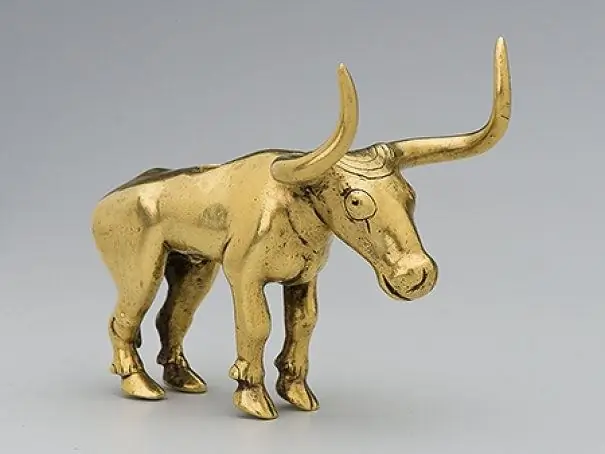- Author Antonio Harrison [email protected].
- Public 2023-12-16 07:44.
- Last modified 2025-01-22 21:44.
The Bronze Age is the period in human history when bronze products played a leading role. The chronological boundaries of the Bronze Age differ from culture to culture, but in general, its beginning dates back to the 35th and 33rd centuries. BC, and completion - by the 13-11 centuries. BC.

Items made of bronze - an alloy of copper made of tin - replaced copper items. Bronze melts at a lower temperature than copper, and products made from it are more durable. The appearance of bronze products contributed to the development of agriculture and the economy in general, which led to the emergence of the first states - these were the civilizations of Mesopotamia, Egypt, Syria, and the Eastern Mediterranean. At the same time, there are vast territories where the way that is characteristic of the previous era - the Eneolithic and Copper Age - is preserved.
Tools and weapons
Speaking about the appearance of bronze tools of labor, one should not assume that they completely supplanted stone ones - during the entire Bronze Age, both tools were used in parallel. In some types of work, stone tools were superior to bronze ones in their qualities - even at the beginning of the Iron Age, the limestone blocks from which the Egyptian pyramids were built were processed with stone tools, bronze was too soft a metal for this. In addition, the deposits of the metals necessary for the manufacture of bronze are not available everywhere.
The first bronze tools were modeled after stone ones. For example, the most ancient bronze ax - a flat celt - resembles a stone one in shape. In the future, axes appear with a blade forged on the sides, parts appear that are designed to more firmly attach the ax to a wooden handle. The bronze spear develops in a similar way. It is noteworthy that some details, having lost their functional significance, remain as decorative elements - for example, rivets on spears.
Art
The art of the Bronze Age has not yet acquired an independent significance. It was closely related to religious beliefs. The most ancient is applied art.
In many cultures of the Bronze Age, ceramics played an important role - for example, in Mesopotamia. Ceramic items were decorated with ornaments bearing a certain mythological meaning: female figures with flowing hair, cross-shaped images symbolizing the sun.
The appearance of the architecture of a particular civilization was determined by the building material available in a given region. In Mesopotamia, it was clay, which influenced not only architecture, but also writing: it was convenient to squeeze wedge-shaped signs on clay tablets with a stick, so cuneiform writing arose. A frame for making raw bricks was invented here, which made it possible to build rectangular temples and palaces. They were trimmed with imported materials - wood and stone. The Egyptians mastered raw brick only by the end of the Bronze Age, but Egyptian pottery is older than Mesopotamian.
In Europe, the Bronze Age is associated with the flourishing of the Minoan civilization that existed in Crete. The most famous monument of Minoan culture is the Palace of Knossos, distinguished by its quirky architecture and complex layout. The frescoes on the walls of the palace depict animals, birds, plants, people performing various rituals. It is noteworthy that among the human figures on the frescoes there is not a single static one - they are all filled with movement. The same can be said for the numerous statuettes found in the palace.
In the 12-13th centuries. BC. many cultures of the Bronze Age disintegrate or change, grandiose migrations of peoples take place. At this time, the development of iron begins, which over time will press the bronze tools. The Bronze Age ends and the Iron Age begins.






